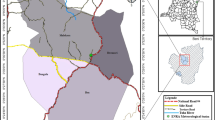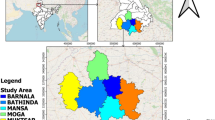Abstract
Evapotranspiration (ET) is one of the most important factors controlling hydrologic, agricultural, and weather cycles. It also converts a large portion of rainfall into vapor, being known as the largest water flux from the earth into the atmosphere. Since ET is affected by many factors, such as land surface characteristics and climatic conditions, it undergoes considerable spatiotemporal variations, particularly at the watershed scale. Hence, to obtain a more accurate estimation of ET, it is required to identify homogenous and uniform regions, each represented by a meteorological station. In this study, three scenarios were proposed in order to identify homogenous regions to estimate ET based on METRIC method, and the scenarios were tested in Sefidrood Watershed in the north of Iran. The first scenario included only vegetation factor with one representative station for the entire case study watershed and ignored diverse conditions affecting ET across the watershed. The second scenario incorporated not only the vegetation factor but also the altitudinal variations of the watershed. In the second scenario, the watershed was divided into two distinct altitudinal sections, each with a representative station with a specific influenced area, with ET being estimated separately for each section. Finally, the third scenario incorporated the altitudinal and climatic variations. The results indicated that the second scenario performed better than two other scenarios in ET estimation. In other words, altitude and vegetation strongly influenced spatial and temporal distributions of ET, leading to considerable variations of it in the watershed.











Similar content being viewed by others
References
Abedini, M. J., & Nasseri, M. (2008). Inverse distance weighted revisited (p. 35). Beijing, China: 4th APHW.
Abrishamkar, M., & Ahmadi, A. (2017). Evapotranspiration estimation using remote sensing technology based on SEBAL algorithm. Iranian Journal of Science and Technology, Transactions of Civil Engineering, 41(1), 65–76.
Al Zayed, I. S., Elagib, N. A., Ribbe, L., & Heinrich, J. (2016). Satellite-based evapotranspiration over Gezira Irrigation Scheme, Sudan: a comparative study. Agricultural Water Management, 177, 66–76.
Allen, R. G., Pereira, L. S., Raes, D., & Smith, M. (1998). Crop evapotranspiration-guidelines for computing crop water requirements-FAO Irrigation and drainage paper 56. Fao, Rome, 300(9), D05109.
Allen, R., Waters, R., Tasumi, M., Trezza, R., & Bastiaanssen, W. (2002a). SEBAL, Surface energy balance algorithms for land, Idaho Implementation. Advanced Training and User’s manual, version 1.0.
Allen, R. G., Tasumi, M., Trezza, R., Waters, R., & Bastiaanssen, W. (2002b). Surface energy balance algorithm for land (SEBAL)–advanced training and user’s manual. Kimberly: Idaho Implementation.
Allen, R. G., Tasumi, M., & Trezza, R. (2007). Satellite-based energy balance for mapping evapotranspiration with internalized calibration (METRIC)—Model. Journal of irrigation and drainage engineering, 133(4), 380–394.
Baeumler, N. W., Kjaersgaard, J., & Gupta, S. C. (2019). Evapotranspiration from corn, soybean, and prairie grasses using the METRIC model. Agronomy Journal, 111(2), 770–780.
Bastiaanssen, W. G. M. (1995). Regionalization of surface flux densities and moisture indicators in composite terrain: a remote sensing approach under clear skies in Mediterranean climates. SC-DLO.
Bastiaanssen, W. G. (2000). SEBAL-based sensible and latent heat fluxes in the irrigated Gediz Basin, Turkey. Journal of hydrology, 229(1–2), 87–100.
Bastiaanssen, W. G., Menenti, M., Feddes, R. A., & Holtslag, A. A. M. (1998a). A remote sensing surface energy balance algorithm for land (SEBAL). 1. Formulation. Journal of hydrology, 212, 198–212.
Bastiaanssen, W. G., Pelgrum, H., Wang, J., Ma, Y., Moreno, J. F., Roerink, G. J., & Van der Wal, T. (1998b). A remote sensing surface energy balance algorithm for land (SEBAL). Part 2: Validation. Journal of hydrology, 212, 213–229.
Bayat, B., Nasseri, M., & Naser, G. (2014). Improving Bayesian maximum entropy and ordinary Kriging methods for estimating precipitations in a large watershed: a new cluster-based approach. Canadian Journal of Earth Sciences, 51(1), 43–55.
Çetin, S., & Köksal, E. S. (2018). Potential use of remote sensing techniques in evapotranspiration estimations at watershed level. Environmental monitoring and assessment, 190(10), 601.
Corbari, C., Mancini, M., Li, J., & Su, Z. (2015). Can satellite land surface temperature data be used similarly to river discharge measurements for distributed hydrological model calibration. Hydrological sciences journal, 60(2), 202–217.
Courault, D., Seguin, B., & Olioso, A. (2003). Review to estimate evapotranspiration from remote sensing data: some examples from the simplified relationship to the use of mesoscale atmospheric models. In ICID workshop on remote sensing of ET for large regions (Vol. 17, pp. 1–18).
Elkatoury, A., Alazba, A. A., & Mossad, A. (2020). Estimating evapotranspiration using coupled remote sensing and three SEB models in an arid region. Environmental Processes, 7(1), 109–133.
Hassaballa, A. A., Matori, A. N., Al-Gaadi, K. A., Tola, E. H., & Madugundu, R. (2017). Sub-pixel analysis to enhance the accuracy of evapotranspiration determined using MODIS images. International Journal of Agricultural and Biological Engineering, 10(2), 103–113.
Jung, M., Reichstein, M., Ciais, P., Seneviratne, S. I., Sheffield, J., Goulden, M. L., & Dolman, A. J. (2010). Recent decline in the global land evapotranspiration trend due to limited moisture supply. Nature, 467(7318), 951–954.
Kunnath-Poovakka, A., Ryu, D., Renzullo, L. J., & George, B. (2016). The efficacy of calibrating hydrologic model using remotely sensed evapotranspiration and soil moisture for stream flow prediction. Journal of hydrology, 535, 509–524.
Kustas, W. P., & Norman, J. M. (1999). Evaluation of soil and vegetation heat flux predictions using a simple two-source model with radiometric temperatures for partial canopy cover. Agricultural and Forest Meteorology, 94(1), 13–29.
Lian, J., & Huang, M. (2016). Comparison of three remote sensing based models to estimate evapotranspiration in an oasis-desert region. Agricultural Water Management, 165, 153–162.
Lima, J. G., Sánchez, J. M., Piqueras, J. G., Espínola Sobrinho, J., Viana, P. C., & Alves, A. D. S. (2020). Evapotranspiration of sorghum from the energy balance by METRIC and STSEB. Revista Brasileira de Engenharia Agrícola e Ambiental, 24(1), 24–30.
Mahab Ghodss Consulting Engineers. (2013a). Updating the water master plan in the basins of Aras (Talesh, Anzali lagoon), Big Sefidrood, (Sefidrood-Haraz), (Haraz-Gharehsou), (Gorganrood-Gharehsou), Atrak, Urmia, the report of agricultural studies and production economics.
Mahab Ghodss Consulting Engineers. (2013b). Updating the water master plan in the basins of Aras (Talesh, Anzali lagoon), Big Sefidrood, (Sefidrood-Haraz), (Haraz-Gharehsou), (Gorganrood-Gharehsou), Atrak, Urmia, the report of surface water resources studies.
Modabberi, H., Mirlatifi, M., & Gholami, M. A. (2014). Determination of evapotranspiration and crop coefficient of two rice types in Mordab Plain (Gilan Province). JWSS., 18(67), 95–106.
Norman, J. M., Kustas, W. P., & Humes, K. S. (1995). Source approach for estimating soil and vegetation energy fluxes in observations of directional radiometric surface temperature. Agricultural and Forest Meteorology, 77(3–4), 263–293.
Pirmoradian, N., Zekri, F., Rezaei, M., & Abdollahi, V. (2013). Derivation of crop coefficients of three rice varieties based on reference evapotranspiration estimation in Rasht region. Cereal Research Journal, 3(2), 95–106.
Praene, J. P., Malet-Damour, B., Radanielina, M. H., Fontaine, L., & Riviere, G. (2019). GIS-based approach to identify climatic zoning: a hierarchical clustering on principal component analysis. Building and Environment, 164, 106330.
Reyes-González, A., Kjaersgaard, J., Trooien, T., Hay, C., & Ahiablame, L. (2017, 2017). Comparative Analysis of METRIC model and atmometer methods for estimating actual evapotranspiration. International Journal of Agronomy.
Ruhoff, A. L., Paz, A. R., Collischonn, W., Aragao, L. E., Rocha, H. R., & Malhi, Y. S. (2012). A MODIS-based energy balance to estimate evapotranspiration for clear-sky days in Brazilian tropical savannas. Remote Sensing, 4(3), 703–725.
Saray, M. H., Eslamian, S. S., Klöve, B., & Gohari, A. (2019). Regionalization of potential evapotranspiration using a modified region of influence. Theoretical and Applied Climatology, 1–13.
Sathiaraj, D., Huang, X., & Chen, J. (2019). Predicting climate types for the Continental United States using unsupervised clustering techniques. Environmetrics, 30(4), e2524.
Su, Z. B. (2002). A surface energy balance system (SEBS) for estimation of turbulent heat fluxes from point to continental scale. In Spectra Workshop (Vol. 474, p. 23).
Sun, Z., Wang, Q., Matsushita, B., Fukushima, T., Ouyang, Z., & Watanabe, M. (2009). Development of a simple remote sensing evapotranspiration model (Sim-ReSET): algorithm and model test. Journal of Hydrology, 376(3–4), 476–485.
Taheri, M., Emadzadeh, M., Gholizadeh, M., Tajrishi, M., Ahmadi, M., & Moradi, M. (2019). Investigating the temporal and spatial variations of water consumption in Urmia Lake River Basin considering the climate and anthropogenic effects on the agriculture in the basin. Agricultural Water Management, 213, 782–791.
Yin, J., Qiu, X., Li, S., Shi, G., & Liu, H. (2020). Estimation of evapotranspiration through an improved daily global solar radiation in SEBAL model: a case study of the middle Heihe River Basin. Hydrology and Earth System Sciences Discussions, 1–32.
Zhang, K., Kimball, J. S., & Running, S. W. (2016). A review of remote sensing based actual evapotranspiration estimation. Wiley Interdisciplinary Reviews: Water, 3(6), 834–853.
Acknowledgments
This work was carried as part of the research project No. 95/32166/720 funded by the Iran Ministry of Energy for revising the national water balance estimation guidelines. The technical supports of the Iran Ministry of Energy and Iran Water Resources Management Company are hereby acknowledged.
Funding
This study was carried out in the Water Institute of the University of Tehran with partial financial support from Iran Ministry of Energy. The financial supports of the Iran Ministry of Energy and Iran Water Resources Management Company are hereby received.
Author information
Authors and Affiliations
Corresponding author
Additional information
Publisher’s note
Springer Nature remains neutral with regard to jurisdictional claims in published maps and institutional affiliations.
Rights and permissions
About this article
Cite this article
Taheri, M., Gholizadeh, M., Nasseri, M. et al. Performance evaluation of various evapotranspiration modeling scenarios based on METRIC method and climatic indexes. Environ Monit Assess 193, 111 (2021). https://doi.org/10.1007/s10661-020-08840-y
Received:
Accepted:
Published:
DOI: https://doi.org/10.1007/s10661-020-08840-y




